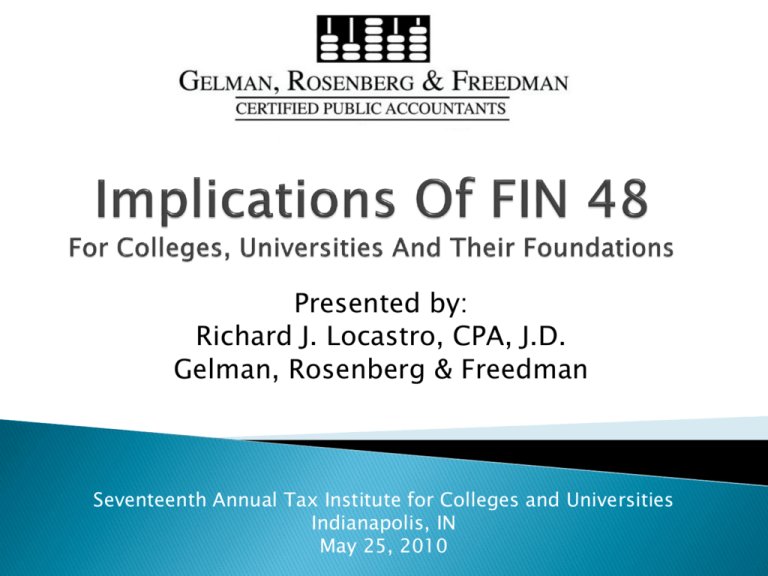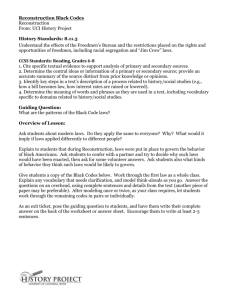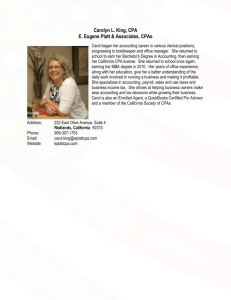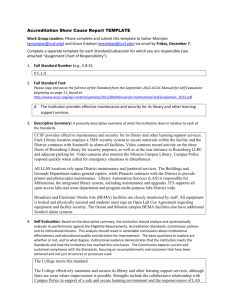
Presented by:
Richard J. Locastro, CPA, J.D.
Gelman, Rosenberg & Freedman
Seventeenth Annual Tax Institute for Colleges and Universities
Indianapolis, IN
May 25, 2010
Richard Locastro, CPA, J.D.
Dick Locastro is a Principal in Gelman, Rosenberg & Freedman’s Nonprofit Tax Department.
Mr. Locastro has over 20 years’ experience providing tax services to tax-exempt
organizations. He spent five years in a National Tax office with Big Four firms, including
three years in KPMG’s Washington National Tax office where he provided tax consulting
services to tax-exempt clients across the country.
His clients included private foundations, colleges, universities, healthcare organizations,
museums and other large nonprofit institutions. Prior to joining Gelman, Rosenberg &
Freedman, he spent three years as the Senior Director of Tax Consulting Services at Arctic
International LLC, where he provided nonresident alien tax consulting services to colleges,
universities, and other tax-exempt organizations.
Mr. Locastro is a member of the American Institute of Certified Public Accountants and the
New York State Bar Association. He received his B.S. Accounting, Magna cum Laude, from
Le Moyne College, Syracuse, N.Y., and his J.D. from the University of North Carolina,
Chapel Hill.
2
Background
Basic structure of FIN 48
Application to Tax-exempt Organizations
Other FIN 48 issues for Preparers and
Organizations
Questions and Answers
©2010 Gelman, Rosenberg & Freedman, CPAs. All rights reserved.
3
FASB Interpretation Number (FIN) 48,
Accounting for Uncertainty in Income Taxes,
was released in July 2006
FIN 48 is an interpretation of FAS 109,
Accounting for Income Taxes and applies to
all entities, including tax-exempt entities,
that prepare GAAP basis financial statements
©2010 Gelman, Rosenberg & Freedman, CPAs. All rights reserved.
4
FAS 109 is now ASC Topic 740 (ASC 740)
FIN 48 concepts are now found throughout
Topic 740
“FIN 48” will be used for presentation
purposes
©2010 Gelman, Rosenberg & Freedman, CPAs. All rights reserved.
5
FIN 48 is generally effective for “public”
entities for fiscal years beginning after
December 15th, 2006
Effective for nonpublic entities for fiscal years
beginning after December 15th, 2008
Most tax-exempt entities would be
considered nonpublic entities
©2010 Gelman, Rosenberg & Freedman, CPAs. All rights reserved.
6
A tax-exempt entity may be considered a
public entity if, for example, it has taxexempt bonds traded in a public market.
©2010 Gelman, Rosenberg & Freedman, CPAs. All rights reserved.
7
FIN 48 determines how to record and
measure a “tax position” for financial
statement purposes
It applies to all entities that prepare GAAP
financial statements
It applies to income taxes – defined as
domestic and foreign federal, state and local
(including franchise) taxes based on income
©2010 Gelman, Rosenberg & Freedman, CPAs. All rights reserved.
9
FIN 48 applies to:
◦ All material tax positions taken or expected to be
taken
◦ On any income tax return
◦ Including those filed or that should have been filed
with federal, state, local or international taxing
authorities
©2010 Gelman, Rosenberg & Freedman, CPAs. All rights reserved.
10
A tax position includes (but is not limited to):
◦ A decision not to file a tax return
◦ An allocation or a shift of income between
jurisdictions
◦ The characterization of income or a decision to
exclude reporting taxable income in a tax return
◦ A decision to classify a transaction, entity, or other
position in a tax return as tax exempt
◦ An entity’s status, including its status as a passthrough entity or a tax-exempt not-for-profit
entity
©2010 Gelman, Rosenberg & Freedman, CPAs. All rights reserved.
11
The “unit of account” depends on the facts
and circumstances
Two factors should be considered:
◦ The manner in which prepares and supports its
income tax return
◦ The approach it anticipates the taxing authority will
take during an examination
For example, with respect to unrelated
business income activities the appropriate
unit of account may be each separate activity
©2010 Gelman, Rosenberg & Freedman, CPAs. All rights reserved.
12
FIN 48 is a two-step process
◦ Recognition
◦ Measurement
FIN 48 uses a “more-likely-than-not” (MLTN)
standard
An organization may not recognize the tax
benefits of a tax position unless it is MLTN,
based on its technical merits, that the tax
position will be sustained upon examination
©2010 Gelman, Rosenberg & Freedman, CPAs. All rights reserved.
13
An organization may not recognize the tax
benefits of a tax position unless it is MLTN,
based on its technical merits, that the tax
position will be sustained upon examination
In assessing whether a tax position is MLTN,
it is presumed that the tax position:
◦ will be examined,
◦ by the appropriate taxing authority, and
◦ the appropriate tax authority has full knowledge of
all the relevant information
©2010 Gelman, Rosenberg & Freedman, CPAs. All rights reserved.
14
The technical merits of a tax position derive
from sources of authority in the tax law (e.g.
legislation, regulations, rulings, cases)
©2010 Gelman, Rosenberg & Freedman, CPAs. All rights reserved.
15
If a position does not meet the MLTN
threshold, no tax benefit may be recognized
If the position does meet the MLTN threshold,
then the tax benefit must be measured
The tax benefit recognized is the largest
amount of tax benefit that is more than 50
percent likely to be realized upon ultimate
settlement
©2010 Gelman, Rosenberg & Freedman, CPAs. All rights reserved.
16
Possible Benefit
Outcome
$100
Percentage
Probability of
Successful
Outcome
5%
Cumulative
Percentage
Probability of
Success
5%
$80
25%
30%
$60
25%
55%
$50
20%
75%
$40
10%
85%
$20
10%
95%
$0
5%
100%
©2010 Gelman, Rosenberg & Freedman, CPAs. All rights reserved.
17
In this example, the amount of tax benefit to
be recognized is $60 – the largest cumulative
benefit that is more than 50% likely
As of each subsequent balance sheet date,
unresolved uncertain tax positions must be
reassessed
©2010 Gelman, Rosenberg & Freedman, CPAs. All rights reserved.
18
Tax positions will fall into one of three
categories with the following consequences:
◦ Highly certain – no liability needs to be accrued
◦ MLTN – amount of liability will have to be
determined
◦ Less likely than not – liability for entire amount (if
material) will be accrued
©2010 Gelman, Rosenberg & Freedman, CPAs. All rights reserved.
19
Recognition or derecognition of the amount
of the tax benefit may occur if:
◦ There are changes in the tax law, regulations, or
new rulings, cases or IRS positions that affect the
evaluation
◦ Statute of limitations expires
◦ The issue is resolved with taxing authorities
©2010 Gelman, Rosenberg & Freedman, CPAs. All rights reserved.
20
Tax positions to be identified include those
taken in all open years
Interest and penalties that would be incurred
if the position was not ultimately sustained
must be accrued
©2010 Gelman, Rosenberg & Freedman, CPAs. All rights reserved.
21
Financial statement disclosure includes:
◦ Total interest and penalties recognized in the
statement of operations and statement of financial
position
◦ A description of tax years that remain subject to
exam by major tax jurisdictions
◦ If the total amount of unrecognized benefits may
reasonably increase or decrease within 12 months,
information about the nature of the uncertainty or
event that could cause the change, is required
©2010 Gelman, Rosenberg & Freedman, CPAs. All rights reserved.
22
Form 990 for 2008 and later requires
disclosure of the text of the FIN 48 footnote
on Schedule D, Part XIV
Roadmap for the IRS?
©2010 Gelman, Rosenberg & Freedman, CPAs. All rights reserved.
23
A tax position includes (but is not limited to):
◦ A decision not to file a tax return
◦ An allocation or a shift of income between
jurisdictions
◦ The characterization of income or a decision to
exclude reporting taxable income in a tax return
◦ A decision to classify a transaction, entity, or other
position in a tax return as tax exempt
◦ An entity’s status, including its status as a passthrough entity or a tax-exempt not-for-profit
entity
©2010 Gelman, Rosenberg & Freedman, CPAs. All rights reserved.
25
Determine all of the organization’s tax
positions
Evaluate the tax positions and determine
which are highly certain, MLTN, or less likely
than not
Consider all open years and all jurisdictions
Determine unit of account for each position
©2010 Gelman, Rosenberg & Freedman, CPAs. All rights reserved.
26
For a tax-exempt organization, common tax
positions are:
◦ Tax-exempt status
◦ Revenue streams as related or unrelated
◦ State filing requirements
©2010 Gelman, Rosenberg & Freedman, CPAs. All rights reserved.
27
Tax-exempt status
◦ Analysis of this tax position should evaluate
whether the organization is organized and operated
for exempt purposes
Organized
◦ Look at IRS determination letter, Articles of
Incorporation and by-laws
◦ Compare Form 1023 (if possible) with current
activities
©2010 Gelman, Rosenberg & Freedman, CPAs. All rights reserved.
28
Operated
◦ Understand current activities and relationship to
exempt status
◦ No political activities
How do we monitor and verify?
Activities of student clubs may pose issue?
◦ Not more than insubstantial lobbying
◦ Private inurement
Compensation
Transactions with insiders
Joint ventures
©2010 Gelman, Rosenberg & Freedman, CPAs. All rights reserved.
29
Operated
◦ Private inurement
Compensation
Transactions with insiders
Joint ventures
©2010 Gelman, Rosenberg & Freedman, CPAs. All rights reserved.
30
Unrelated Business Income
◦ Analyze all revenue streams
◦ Categorize as related, unrelated or excluded
◦ Determine whether the tax position for each is
highly certain, MLTN, or less likely than not
◦ For positions that are not highly certain, measure
potential liability and determine if material
©2010 Gelman, Rosenberg & Freedman, CPAs. All rights reserved.
31
Unrelated Business Income
◦ For revenue that is reported as unrelated, evaluate
the expense allocations and determine if
methodology is consistent with IRC and IRS
guidance
©2010 Gelman, Rosenberg & Freedman, CPAs. All rights reserved.
32
Unrelated Business Income
◦ In addition to analyzing revenue streams, don’t
forget:
Alternative investments (K-1s)
Transactions with controlled entities
Joint ventures
©2010 Gelman, Rosenberg & Freedman, CPAs. All rights reserved.
33
Jurisdictional Issues – State filings
◦ Where is the organization currently filing income
tax returns?
◦ Which states should the organization be filing
income tax returns?
◦ Do any states in which the organization has nexus
require filing for state recognition of exemption?
©2010 Gelman, Rosenberg & Freedman, CPAs. All rights reserved.
34
Jurisdictional Issues – State filings
◦ Potential sources of nexus to other states may
include:
Employees in other states (including telecommuting)
Publishing or sales activities
Business activities through investments (e.g. real
estate owned in another state through a partnership)
©2010 Gelman, Rosenberg & Freedman, CPAs. All rights reserved.
35
Jurisdictional Issues – Foreign
◦ International activities could result in foreign filing
requirements:
Employees in other countries
Campuses or other programs
Investment activity
©2010 Gelman, Rosenberg & Freedman, CPAs. All rights reserved.
36
Remember - FIN 48 Analysis should:
◦ Include all open tax years
◦ Aggregate all uncertain tax positions
◦ Determine if interest and penalties apply
©2010 Gelman, Rosenberg & Freedman, CPAs. All rights reserved.
37
Role of Counsel and privilege in preparation
of FIN 48 analysis
◦ Can privilege apply and does inclusion of analysis in
audit workpapers impact privilege?
IRS Roadmap
◦ IRS generally does not go after tax accrual
workpapers in an audit, but it appears IRS may be
rethinking its policy
©2010 Gelman, Rosenberg & Freedman, CPAs. All rights reserved.
39
Impact on Paid Preparers
◦ Professional standards can impose sanctions for
preparers for tax positions that are not MLTN
unless properly disclosed
◦ If FIN 48 analysis concludes position is not MLTN
Does paid preparer know?
If so, disclosure of position may be required
©2010 Gelman, Rosenberg & Freedman, CPAs. All rights reserved.
40
Richard Locastro, CPA, J.D.
Principal, Nonprofit Tax Department
rlocastro@grfcpa.com or 301-951-9090
Gelman, Rosenberg & Freedman, CPAs
4550 Montgomery Avenue, Suite 650 N
Bethesda, MD 20814
www.grfcpa.com








